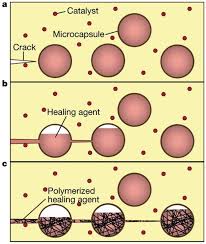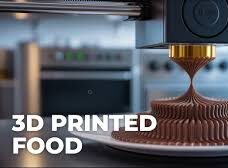Introduction
Picture this: you drop your brand-new phone, your heart sinks, and you brace yourself for the sight of spiderweb cracks across the screen…
But instead, you watch in amazement as the cracks slowly vanish, leaving your phone as good as new. No repair shop, no replacement screen — just science doing its magic.
This isn’t a sci-fi movie scene; it’s the promise of self-healing materials — an innovation that could completely change how we think about device durability. From smartphones to spacecraft, these materials can repair themselves after damage, saving money, reducing e-waste, and making technology more resilient.
In this blog, we’ll explore 7 incredible ways self-healing technology is set to make cracked screens a thing of the past.
1. Polymer-Based Healing Coatings
Self-healing polymers are made from chains of molecules that can reconnect when broken. When damaged, heat or light triggers them to reform their original structure.

Impact:
- Extends the life of screens by years.
- Significantly reduces repair costs.
Example: LG once introduced a smartphone back cover that could heal minor scratches in minutes — an early glimpse into what’s possible for full screens.
2. Microcapsule Healing Agents
These materials contain microscopic capsules filled with a repair agent. When a crack appears, the capsules break, releasing the healing substance that hardens and seals the damage.
Impact:
- No external tools or intervention required.
- Repairs are invisible to the naked eye.
This technology could be especially useful in wearables, where constant contact and scratches are inevitable.
3. Heat-Activated Recovery
Some materials can heal when exposed to warmth — even from your own hands. A small amount of heat softens the damaged surface, allowing the molecular structure to realign.
Impact:
- Passive healing during regular device use.
- Low-energy process means minimal strain on battery.
Imagine simply holding your cracked phone for a few minutes and watching the damage disappear.
4. Light-Responsive Healing
Photo-reactive polymers use UV light to trigger repairs. Outdoor sunlight or a small built-in UV light can activate the process.
Impact:
- Ideal for outdoor tech like tablets for fieldwork.
- Hands-off repair — nature does the work.
Future devices could have an “auto-heal” mode that activates when left in sunlight.
5. Nanotechnology-Based Healing
By embedding nanoscale structures into the screen, engineers can create materials that not only heal but also prevent damage from spreading.
Impact:
- Maintains clarity and touch sensitivity.
- Distributes stress to stop fractures early.
NASA is already experimenting with similar nanomaterials for spacecraft surfaces, where repairs in space are far more challenging.
6. Hybrid Material Composites
These combine the strength of glass with the flexibility of self-healing polymers. This “best of both worlds” approach creates screens that can flex slightly on impact, preventing shattering.
Impact:
- Survives bigger drops without breaking.
- Maintains high display quality.
Foldable phones could benefit massively from this combination.
7. AI-Driven Damage Detection
AI can be integrated into devices to monitor micro-damage in real time. Once detected, the device could trigger the self-healing process automatically.
Impact:
- Prevents small cracks from becoming costly repairs.
- Works in the background without user input.
This could be game-changing for industries like aviation and defense, where safety is paramount.
Why This Matters to You
- Cost Savings: No more paying thousands for new devices.
- Eco-Friendly: Reduces e-waste from discarded screens.
- Convenience: No downtime without a functioning device.
Challenges Ahead
- Production Costs: Still expensive to mass-produce.
- Long-Term Durability: Needs real-world stress testing.
- Compatibility: Must integrate with OLED, AMOLED, and other display tech.
The Future of Unbreakable Screens
With major brands like Samsung, Apple, and Motorola investing in self-healing technology, we could see commercial products within the next decade. As costs drop, self-healing materials could become standard — not just in phones, but in laptops, TVs, and even car windshields.
Soon, “I cracked my screen” might join “I forgot to rewind the VHS” in the list of problems that no longer exist.
Final Word:
Self-healing materials are more than a cool gadget feature — they represent a shift toward sustainable, long-lasting technology. Whether it’s through polymers, nanotech, or AI integration, the end of cracked screens is closer than ever.
Imagine dropping your phone, seeing the dreaded spiderweb cracks… and then watching them disappear on their own. No repair shops, no screen replacements — just like magic. Thanks to self-healing materials, this future is becoming a reality. These revolutionary materials can repair themselves after damage, promising longer-lasting devices and less e-waste.
In this blog, we’ll explore 7 fascinating ways self-healing technology is changing screens forever.
1. Polymer-Based Healing Coatings
Self-healing polymers are designed to “remember” their original shape. When damaged, heat or light triggers them to reform their bonds and restore their surface.
Impact:
- Extends screen life by years.
- Reduces costly replacements.
Case Study: LG developed a self-healing smartphone back cover that repaired minor scratches in minutes.
2. Microcapsule Healing Agents
Some materials embed tiny capsules filled with repair agents. When cracks occur, these capsules break open and release the substance, filling in the damaged area.
Impact:
- Works without external intervention.
- Repairs happen at a microscopic level, keeping clarity intact.
3. Heat-Activated Recovery
Certain self-healing materials repair themselves when exposed to body heat or mild external heating.
Impact:
- Perfect for mobile devices that are often in hand.
- Low-energy process means less strain on battery life.
4. Light-Responsive Healing
Innovations in photo-reactive polymers allow cracks to seal when exposed to UV light.
Impact:
- Ideal for outdoor use where sunlight can trigger repairs.
- Low maintenance — just let nature do the work.
5. Nanotechnology-Based Healing
By embedding nanostructures into glass or plastic, engineers can create screens that redistribute stress and heal small fractures.
Impact:
- Maintains high resolution and touch sensitivity.
- Could revolutionize tablets and laptops.
6. Hybrid Material Composites
Combining glass with flexible self-healing polymers ensures both strength and adaptability.
Impact:
- Devices can survive drops from higher heights.
- Prevents shattering while allowing clear display quality.
7. AI-Driven Damage Detection
Pairing self-healing materials with AI algorithms can detect micro-damage early and trigger repairs automatically.
Impact:
- Prevents small cracks from spreading.
- Increases lifespan of screens significantly.
Consumer Benefits
- Cost Savings: Fewer repairs and replacements.
- Eco-Friendly: Reduced e-waste from discarded screens.
- Convenience: Less downtime without a functioning device.
Challenges to Overcome
- Material Costs: Self-healing tech is still expensive to mass-produce.
- Durability Testing: Long-term wear resistance must be proven.
- Integration: Needs to work with existing display tech like OLED and AMOLED.
Future Outlook
Tech companies like Samsung and Motorola are investing heavily in this technology. Within the next decade, cracked screens might become as outdated as flip phones.
Final Thoughts
Self-healing materials are more than a cool sci-fi concept — they’re a practical solution to one of tech’s most annoying problems. From polymers to nanotech, the innovations in this space promise a future where accidents don’t cost hundreds of dollars to fix.





